Domain: Eukaryotes AnimalsType: ShellfishClass: Cephalopods
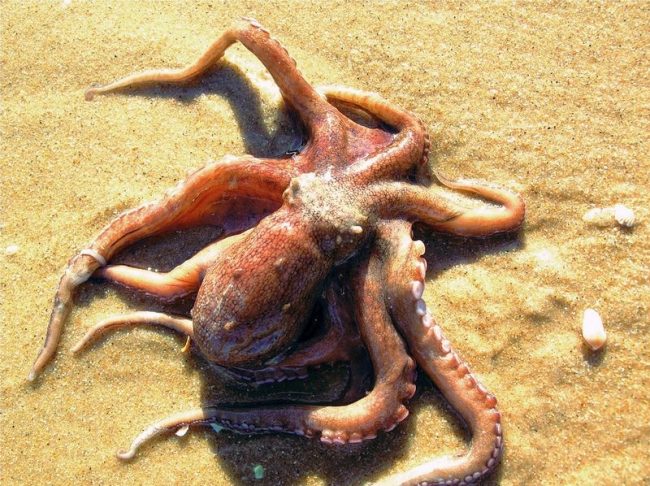
The majestic inhabitant of the sea, small and large, the octopus is still a mystery to humans. Spherical body, long tentacle hands, nose-beak and the highest intelligence connected in one animal and turned him into a hero of Hollywood thrillers
Content
- 0.1 Content
- 1 Description of the octopus
- 2 Building
- 3 Color
- size 4
- 5 Habitat
- 6 Behavior
- 7 Nutrition
- 8 Enemies
- 9 Reproduction
Content
Contents
- Octopus description
- Structure
- Color
- The size
- Habitat
- Behavior
- Nutrition
- Enemies
- Breeding
The majestic inhabitant of the sea, small and large, the octopus is still a mystery to humans. Spherical body, long tentacle hands, nose-beak and the highest intelligence connected in one animal and turned him into a hero of Hollywood thrillers. However meaningful behavior and formidable appearance is not a reason to rank octopus to monsters.

Everything is unusual in the structure of the octopus, but the answer to the question how many hearts does an octopus have, the answer will surprise many: it has three of them
Octopus description
Everything is unusual in the structure of the octopus, but the answer to the question how many hearts an octopus has will surprise many with an answer: it has three of them. On the Only a few animals have such an unusual reserve on earth. hearts. The earthworm and mexin fish even outdid the mollusk and got five and four hearts.
The octopus squad includes all kinds, from the smallest to giants living in all subtropical and tropical seas and oceans of the planet.
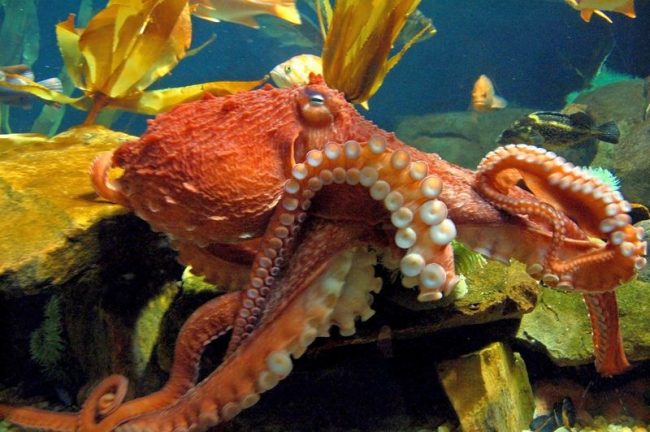
The tentacle arms, in the amount of 8 pieces, help the clam move around and grab food. They are interconnected eardrums. On their inner surface are suction cups, responsible for holding prey
Structure
What a simple layman takes for a head is actually there is a clam body. It is soft, oval, and quite short relative to its tentacles. Where the “arms” meet octopus, located mouth, which is armed with two jaws in the shape of beak. The pharynx of an animal resembles a grater with which it grinds food. Powerful jaws and a strong grater with rows of small teeth crack shell of mollusks and allow you to get to tender meat.
The tentacle arms, in the amount of 8 pieces, help the clam move around and grab food. They are interconnected eardrums. On their inner surface are suction cups, responsible for the retention of prey. One individual can count up to 2 000 such suction cups. On the tentacles are taste buds. an animal telling him whether edible prey was caught in “hands”.
Interesting! The octopus has 6 arms and 2 legs. Two tentacles are adapted to walk along the bottom that he with success and doing at great depths.
The eyes of the cephalopod are equipped with a lens, and are very similar on human, only his pupil is rectangular, and not round, like people. That’s why his look seems to us on an alien reasonable and wise.
The octopus has no hearing organ, but it breathes with gills. Concerning hearts, then he really has three. The main thing is responsible blue blood flow throughout the body of the mollusk, the other two are placed under the gills, and they push blood through them.
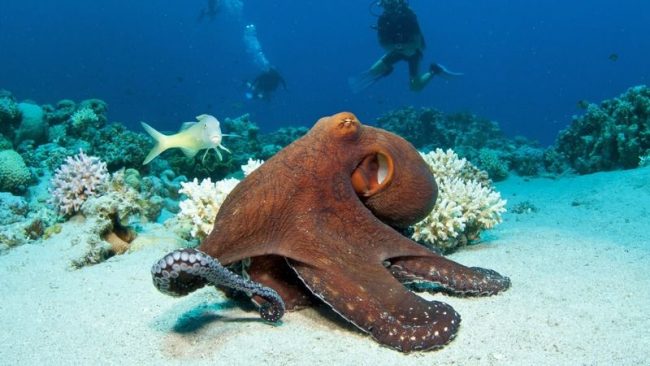
When calm, the octopus is brown. However pigments in the skin cells help the mollusk quickly change color
Color
When calm, the animal is brown. However, there are pigments in the skin cells that help the mollusk. change color quickly. If an octopus is frightened of something, it turns white, and when very angry, his body becomes crimson. During hunting octopus, like a chameleon, can reproduce on its skin drawing of the surface behind which it lurked.
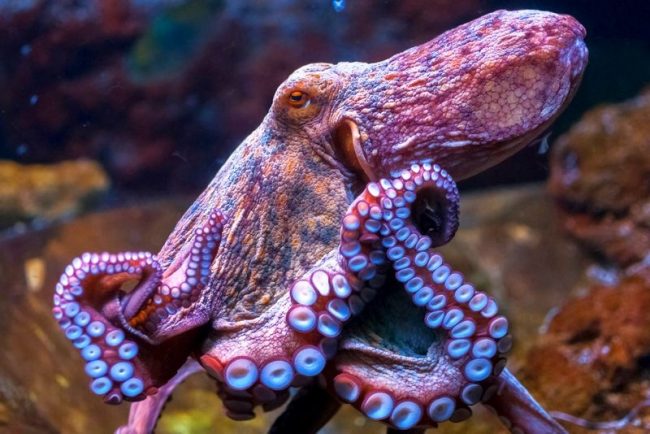
The octopus is medium in size. Standard length for males is 1.3 meters, for females – 1.2 meters. She measured with taking into account the tentacles, the body of a mollusk can be from 30 to 50 length see. Weight reaches 10 kg, but most specimens weigh from 5 to 7 kg
The size
The standard length for males is 1.3 meters, for females – 1.2 meters. It is measured taking into account the tentacles, the body of a mollusk can be from 30 to 50 cm long. Weight reaches 10 kg, but most specimens weigh from 5 to 7 kg. As you can see impressiveness here and does not blow. Giant Octopus Legends were written in antiquity when people did not have the opportunity take a closer look at this harmless creature.
Interesting! The biggest octopus is rocky octopus. Guinness Book is officially registered mollusk with tentacles 3.5 meters long and weighing 58 kg.
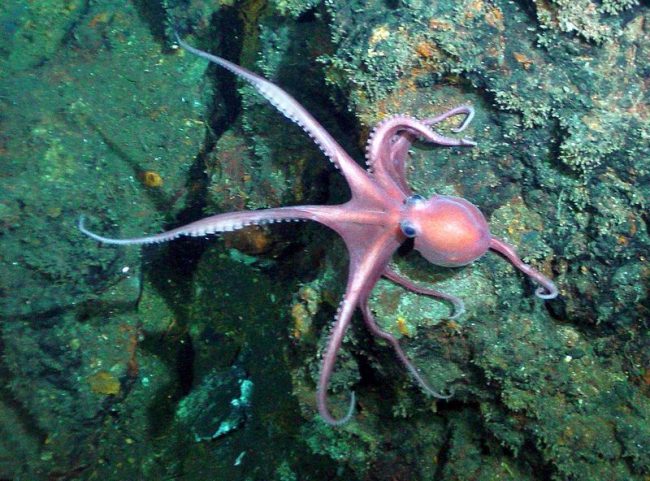
For a quiet life, he needs rocky shores, where he can arrange a refuge in one of the natural caves. Not having skeleton, octopus easily fits into any hollow niche and crevice, hiding from predators and resting in them during the day
Habitat
Permanently living in tropical and subtropical waters, octopus prefers a salinity of at least 30%. Some species live in shallow water, others like to go deeper, on 100-150 meters from the surface.
For a quiet life, he needs rocky shores, where he can arrange a refuge in one of the natural caves. Not having the skeleton, the mollusk easily fits into any hollow niches and crevices, hiding from predators and resting in them during the day. He goes hunting at night. If there are no rocks, the octopus does an excellent job the construction of a real fortress from improvised materials or digs a deep hole in the ground, equipping its nest.
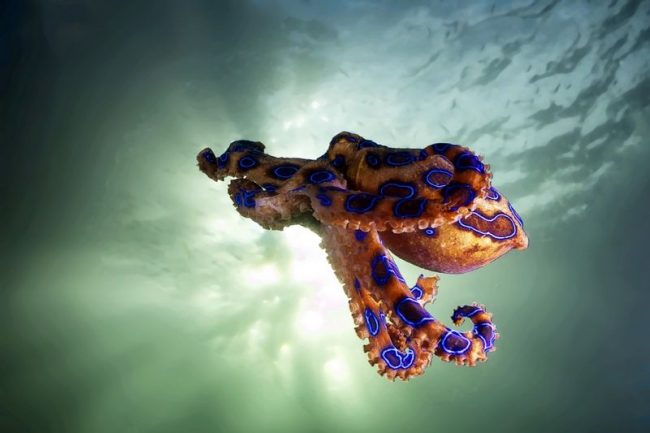
An octopus is characterized by a nocturnal lifestyle. He is careful and shy, able to hide quickly or flees from danger, releasing ink stain
Behavior
An octopus is characterized by a nocturnal lifestyle. He is careful and shy, able to hide quickly or flees from danger, releasing ink stain.
The mollusk loves its home, and it is kept in perfect purity, sweeping all debris with a jet of water from the funnel. Scraps he stores outside the shelter.
When arranging a house, the octopus makes it wide inside, leaving it narrow passage to protect yourself from enemies.
The octopus likes to drag everything that is badly lying on the sea into the house the bottom. Crates, plastic bottles, rubber boots, tires can become his house, but he’ll definitely drag something there too.
For wintering, the mollusk goes to the depths of the ocean, and in summer prefers to hunt in shallow water.

To get food, the octopus learned to disguise well. Seeing a potential victim, he merges with the situation. When the prey approached a throwing distance, the octopus pounced on her and releases poison, paralyzing the game
Nutrition
The main diet of the animal consists of crayfish, crabs and other shellfish. However, he can eat everything that moves, if he can deal with it. On his menu, and fish, and plankton, and snails. To get food, octopus learned to disguise well. Seeing potential victim, he merges with the situation. When is the prey approached a throwing distance, an octopus pounces on her and releases poison, paralyzing the game. The poison is formed in the salivary glands. animal and is sacrificed through a wound done by the beak.

Whales, killer whales, dolphins, moray eels, seals, sea lions, and sharks large seabirds are all natural enemies of octopuses
Enemies
Whales, killer whales, dolphins, moray eels, seals, sea lions, and sharks large seabirds are all natural enemies of octopuses. Man hunts for him too. Which of us has not tried a cocktail from seafood with little octopuses or not treated canned octopus meat.

For breeding in males, one tentacle was modified under copulatory organ. The mating dance of animals reminds friendly tentacle shakes. A male octopus holds a female for them, fertilizing her
Breeding
For breeding in males, one tentacle was modified under copulatory organ. The mating dance of animals reminds friendly tentacle shakes. The male holds the female for them, fertilizing her. A week passes, and the female octopus leaves to lay eggs. For masonry, she selects a well-sheltered place, and the masonry itself is similar to a large bunch of grapes.
Mom octopus is very caring and fearless. They are desperate protect their offspring, care for them, providing future octopuses inflow of fresh water and constantly clearing eggs from dirt and garbage. The rate of offspring development depends on the temperature of the water. The usual incubation period is 4 to 6 weeks.
Interesting! Life Span octopus is 4 years old, but females live less on average about two years. Sexual maturity in females occurs with a weight of 1 kg, and males are ready for mating and weighing 100 g.
In the days when an octopus chooses a bride for himself, he becomes aggressive, and forgets about caution. Meeting with a large individual in such a moment could end for a person with serious injuries.
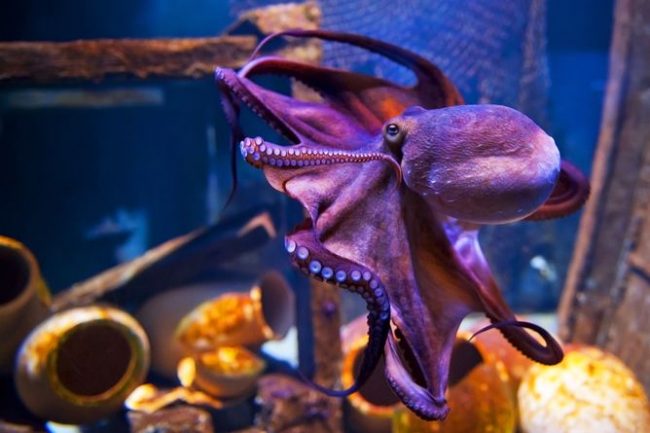
Of course, the octopus inspires respect and a share of fear, but dispelled science myths about the bloodthirstiness of the animal brought him to the page children’s books and cartoons. In them he is funny and funny.
Of course, the big octopus photo inspires respect and a share of fear, but science-dispelled myths about the bloodthirstiness of the animal brought him to page for children’s books and cartoons. In them he is funny and cheerful.
Adults entrusted the octopus Paul to predict the outcome of matches on soccer world cup in 2010. And he did not fail them, 80% of him forecasts turned out to be correct. Unfortunately, the octopus age is short-lived, and we will have to look for another oracle.






